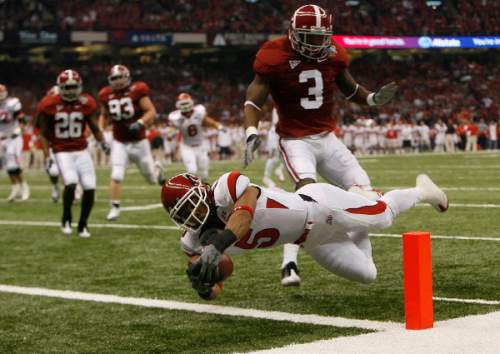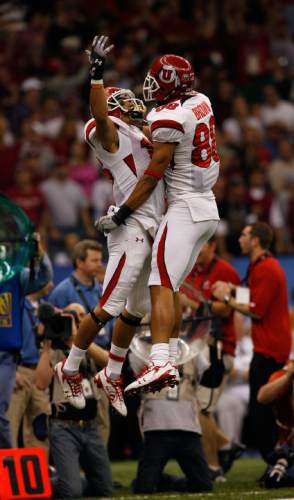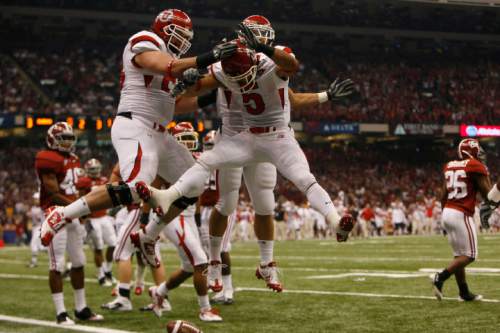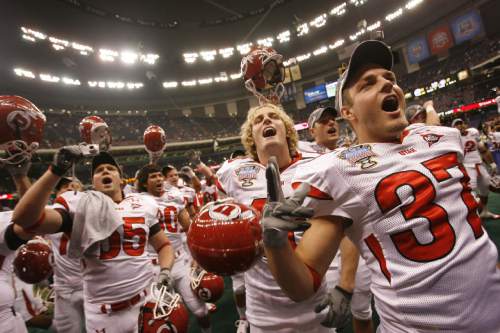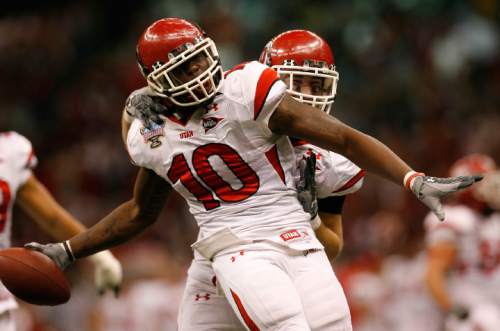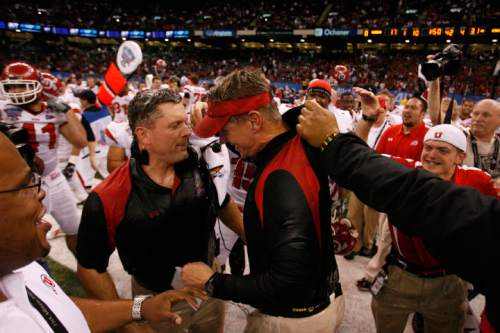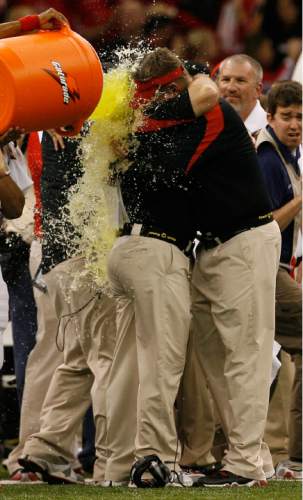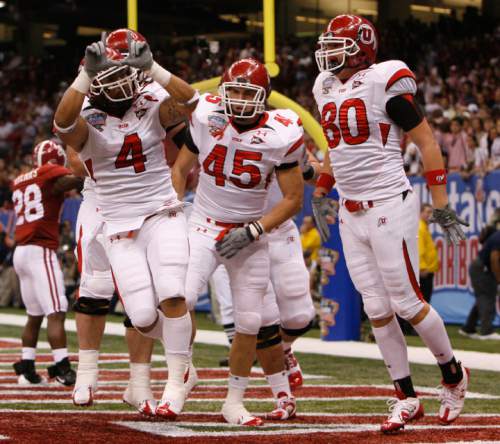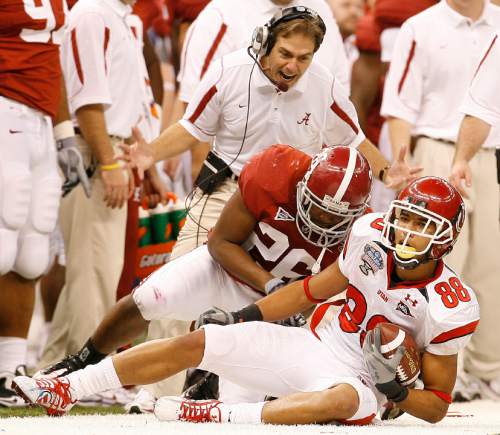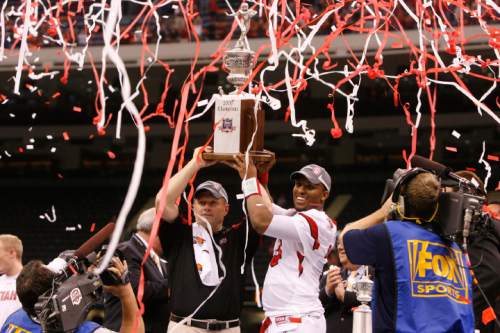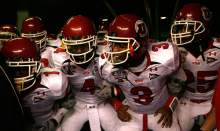This is an archived article that was published on sltrib.com in 2016, and information in the article may be outdated. It is provided only for personal research purposes and may not be reprinted.
In Monday night's national championship game vs. Clemson, Alabama can win a fourth title in seven seasons. The Crimson Tide's reign stemmed from an unlikely starting point — a Sugar Bowl loss to Utah.
The developments of the past seven years make the Utes' 31-17 victory seem both more stunning and more understandable, if that's possible. The rarely mentioned explanation? Utah's personnel, when judged by ongoing NFL careers and college performances, was just as good as Alabama's — if not better than the Tide's, in some key positions.
Undoubtedly, the 2008 Utes maximized a psychological edge as a program from outside the power conferences that was trying to complete an unbeaten season in New Orleans, facing an Alabama team that was coming off a loss in the Southeastern Conference championship game and missed a national title shot in coach Nick Saban's second season. Yet that popular narrative overlooks the fact Utah was very well-equipped to meet the Tide.
The mystery, looking back, is how Utah could have recruited and developed such a convergence of players in the school's Mountain West era. (Did Utah's 2015 team, for instance, include 16 future NFL players? We'll find out). The Utes seemingly never have been as loaded with NFL prospects before or since that '08 season — and that's not even counting quarterback Brian Johnson and punter-kicker Louie Sakoda, two of the school's most celebrated players, who never made it in pro football.
The core of that '08 team produced Utah's biggest all-time impact in the NFL Draft, by far. Ten players were picked in the two drafts following that season, including four second-rounders: defensive end Paul Kruger, cornerback Sean Smith, linebacker Koa Misi and offensive lineman Zane Beadles. In all, 16 players from the Sugar Bowl roster would be drafted and/or have extended NFL careers, including free agents Matt Asiata, Derrick Shelby and Sealver Siliga, all thriving in the league.
The Utes featured poised, experienced athletes and big-time playmakers on both sides of the ball. Johnson passed for 336 yards and three touchdowns in his 33rd career start, operating a fast-paced offense that was designed, in former offensive coordinator Andy Ludwig's modest words, to "take the coaches out of the game." Defensive coordinator Gary Andersen also was involved in his last game with the Utes, having accepted the Utah State head coaching job. His group featured linebacker Stevenson Sylvester, who recorded three of Utah's eight sacks, and safety Robert Johnson, who had two interceptions.
Acknowledging that quarterback Alex Smith was the NFL's No. 1 overall pick, the Utes' other unbeaten team in the modern era ('04) couldn't match the '08 roster's overall talent level. The '04 team produced only six other picks in two subsequent drafts, with one player higher than a sixth-rounder. Even counting safety Eric Weddle, then a sophomore who became a second-rounder, that team falls short.
Further illustrating the '08 team's unusual talent level, offensive lineman Tony Bergstrom (then a freshman), would become the only Ute taken in the 2012 draft. A total of four players were picked the next two years, followed by four in 2015. Utah also expects to fare well in the 2016 draft after its fifth season of Pac-12 play, but it seems unlikely that the 2015 roster would project anywhere near the 16 success stories of '08.
Alabama, meanwhile, keeps increasing its talent level. In the past three drafts, from recruiting classes that followed the Sugar Bowl, 24 players have been picked, including 10 in the first two rounds. Saban was just getting started, as of '08. Offensive tackle Andre Smith was the No. 6 pick in the draft, but he was suspended for the Sugar Bowl.
The Tide's active roster that night listed three third-rounders in the upcoming draft, although seven more players would be drafted the next year. Three others would become first-rounders in two years, including running back Mark Ingram, the 2009 Heisman Trophy winner as a sophomore. Ingram ran for 26 yards on eight carries against Utah. Julio Jones, also a freshman in '08, became the biggest NFL star from that matchup. The current All-Pro selection caught seven passes for 77 yards.
So Alabama was not exactly at a talent disadvantage. Utah outplayed the Tide. Johnson's passing, in particular, exploited a secondary that featured some highly drafted players, and Alabama's offense posted only 208 total yards.
In the past seven years, covering the transition to the Pac-12, Utah has gone 57-32. Alabama is 85-10 since that night in New Orleans, losing only to South Carolina, LSU (twice), Auburn (twice), Texas A&M, Oklahoma, Ole Miss (twice) and Ohio State. The Tide's subsequent success gives the '08 Utah team a permanent place in college football lore, while present and future Utes keep trying to live up to that performance.
Twitter: @tribkurt —
A talented team
Utah players drafted into the NFL from the 13-0 team of 2008 (round in parentheses):
2009 draft • Paul Kruger, DE (2); Sean Smith, CB (2); Brice McCain, CB (6); Freddie Brown, WR (7).
2010 draft • Koa Misi, LB (2); Zane Beadles, OL (2); Robert Johnson, DB (5); David Reed, WR (5); Stevenson Sylvester, LB (5); R.J. Stanford, CB (7).
2011 draft • Brandon Burton, CB (5); Caleb Schlauderaff, OL (6).
2012 draft • Tony Bergstrom, OL (3).
Prominent free agents • Matt Asiata, RB; Derrick Shelby, DE; Sealver Siliga, DT.
—
Utah's tie to the Tide
Cottonwood High School graduate Cooper Bateman, who wears No. 18, is Alabama's No. 2 quarterback and regular holder for place-kicks as a sophomore. Bateman has attempted passes in five games this season, going 37 of 51 for 291 yards and one touchdown, with two interceptions. He started in Alabama's loss to Ole Miss and went 11 of 14 for 87 yards with one interception before Jake Coker replaced him in the second quarter.


